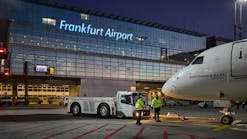Many airports are increasingly looking at both sides of the energy equation — not only how to control demand, but how to get the most out of their supply. “Energy and sustainability have been a hot button on and off for the last couple of years,” says Bill Fife, corporate vice president and director of aviation services for DMJM Harris. Airports embracing this strategy are reaping the benefits of their investment, both for their business and their bottom line.
“I’ve been dealing with this issue for over 40 years,” says Fife. “It’s not going to go away.” Fife says that the first step for any airport serious about sustainability is in its master plan.
“It requires an effort that looks beyond what the normal FAA requirements are for a master plan,” says Fife. The FAA does not require a section on energy in master planning, but Fife believes that will change as FAA turns its attention to elements of airports beyond airspace and airfields. He says that it will affect airports of every size.
“You can do a master plan for a million passenger airport or a 45 million passenger airport — it’s not different. Just break it down into manageable components, down to the lowest common denominator. You can do it in your home or you can do it on a mega campus. You just have to have the commitment to do it.
“The key thing is it has to start early. You have to go in with a basic plan that you’re going to do it right.”
Losing faith in the grid
There’s no set path for getting the best deal on electricity. Many airports could be considered trailblazers in this area. Then again, many aren’t doing much at all.
“Most airports run off the [local utility company’s electrical] grid,” says Scott Clark, P.E., CEM, principal of facilities division energy and power solutions at Carter & Burgess.
But given recent events with the nation’s infrastructure, some airports are beginning to look for more reliable sources.
“It used to be that you saw the grid as unflappable, it would never go down and you could always count on it,” says Clark. “Well, in the Midwest and the Northeast and even in California and Texas there have been widespread transmission failures where hundreds of thousands of acres have gone black because of some sort of transmission failure in the infrastructure.
“The transmission grid has not kept up with the growth over the last 20 to 30 years. From a reliability standpoint, a lot of people have either experienced outages and they want to do something about it, or they’ve read about outages in other places and they don’t want it to happen to them.”
Fife agrees. “My approach on this, and it’s something you’re beginning to see because of the tragedy of the bridge falling down in Minneapolis, people are beginning to realize that you have to invest in infrastructure. It’s not just spending money.”
Cogeneration gains ground
Ali Dib, P.E., director of facilities and infrastructure, says Detroit Metropolitan Wayne County Airport installed cogeneration in its new terminal opened in 2001, partially because there was no infrastructure already in place.
“The decision was made, that if we were going to build the infrastructure for the new facility, we might as well have redundancy with cogeneration,” Dib says.
The cogeneration plant cost $70 million ‘from scratch’, including building generators, engines, boilers, and chillers. Dib says that the plant was paid for primarily by outside investors, whom DTW is paying back monthly. The plant is operated by an outside company hired by the airport.
DTW still operates primarily off the grid. A deal was reached with the local utility company to power the airport with ‘interruptible power,’ which can be shut off at the utility’s request during peak demand times. Interruptible power costs two to three cents less per kilowatt.
The cogeneration plant can be powered using either natural gas or jet fuel, depending on whichever costs less at the time. “If [the utility company] needs to interrupt, they give us an option,” Dib explains. “We can either generate or pay a penalty for not shutting down. It’s a business decision. And in most cases, we have been cogenerating because it’s cheaper than paying the penalty.” DTW has even generated a surplus of energy and sold it back to the grid at times.
Clark at Carter & Burgess agrees with the philosophy used at DTW, and sees it being increasingly used in the future. “The industry’s gone through about a five- or six-year lull period after 9/11,” Clark says. “And now we’re seeing a tremendous amount of airport activity again in the last year or so, and there’s a lot of pent-up demand for facilities and airport growth.
“It’s incumbent on airports to really think about the infrastructure side of the equation and not just think about the terminal and how many gates they need.”
Dib says that the cogeneration plant has already proven its value as a reliable source of power during a crisis. In 2003, Michigan was one of five states that lost power for several days. “In four seconds, that cogeneration was up and running and we were able to fly airplanes,” Dib says. “The rest of the state was dark, but the airport was running.
“That’s one of my objectives, is to try to save money and stay in business if there’s a grid interruption.”
Port Columbus (Ohio) International Airport considered cogeneration for its 2003-2004 Port Columbus Master Plan update, but decided against it because of a poor return on investment considering the current low cost of electricity there.
Dallas Fort Worth International Airport is also considering cogeneration as an option, as drilling for natural gas under their airfield, to which it owns the rights, recently began.
“It’s not a typical situation, it’s very unique to DFW,” Clark says. “It opens another whole opportunity to generate power on the airport property, because they have a fuel source that they own.”
Cogeneration is 35 to 45 percent more efficient than typical utility systems, because heat generated from producing power is used in the facility’s heating and cooling systems, rather than going to waste.
“There’s also environmental benefits,” says Clark. “The latest technology that the Texas Council of Environmental Quality would require for new generation equipment produces a fraction of the emissions current utility plants emit. So you actually get a regional emissions benefit by having onsite generation.”
So far, cogeneration hasn’t taken the industry by storm — yet. “I think there’s only three or four airports currently using cogeneration,” says Fife.
Cogeneration has gained a lot of ground in another, somewhat similar industry — universities. “Universities by their nature tend to think long-term,” says Clark. “They’ve been around for 100 years, and they know they’re going to be around for another 100 years, so that’s how they approach it. Airports could learn from that model.”
Going for the green
Some airports are also keeping an eye out for renewable energy opportunities. Dib says DTW has considered several renewable energy fuel sources for the cogeneration plant in the second new terminal to open next year. One or two seem particularly viable, he says, and they hope to make an announcement on the subject soon.
Steve Wareham, airport director of Minneapolis/St. Paul International Airport, says MSP tried to buy a hydroplant built on the Mississippi River when it was up for sale recently, due to a Ford manufacturing plant closing.
“We analyzed it financially and with our energy consultants,” Warehem explains. “In the end we decided it could have been a very advantageous thing to have. Slightly out of our core mission, but we thought it’d be great to basically have our own ‘power source.’”
Lacking the necessary transmission infrastructure, MSP would have generated the power and sold it to the grid, then bought it back. It would have been one of the first fully ‘green’ airports in terms of renewable energy, says Wareham.
“We would have had renewable energy resource credits that we perhaps could have traded on the open market,” Wareham says. “In fact, I think that’s why we didn’t win the bid. The Canadian utility company [that won the bid] was probably looking at these deferred emission credits and renewable energy credits that they could sell off that would be worth a lot more than they are perhaps today.”
Getting renewable energy isn‘t so easy for many airports. “When you get to the scale that most airports are, it’s pretty tough for them to have their own wind generator or hydroelectric plant,” Clark says. “But they may have the option of buying renewable energy.”
That kind of renewable energy costs more than standard electricity. But, Clark says, “It shows a commitment to sustainability and the environment.”
The PR aspect isn’t lost on Dib. “You have to remember that we are accused of harming the environment — airport operations in general,” he says.
And while cogeneration may not be understood by the general public, renewable energy like solar or wind power has a better chance. “People can relate to that, things they can see and feel.”
No matter what power source is selected in the end, Clark says the energy supply planning approach is the same. “You need to do a detailed feasibility study, because every location is different,” Clark says.
“The feasibility study would look at concept design, how the system would be configured, what the loads are that it would serve, what the capital costs would be, and what the savings would be. Then do overall lifecycle costs and the overall cost/benefit analysis.”
Energy planning is not going away any time soon. Comments Fife, “Climate change and the environment and energy costs are real. It’s not just a technical issue. It’s a business issue; it’s a financial issue; and it’s a strategic planning issue.”




